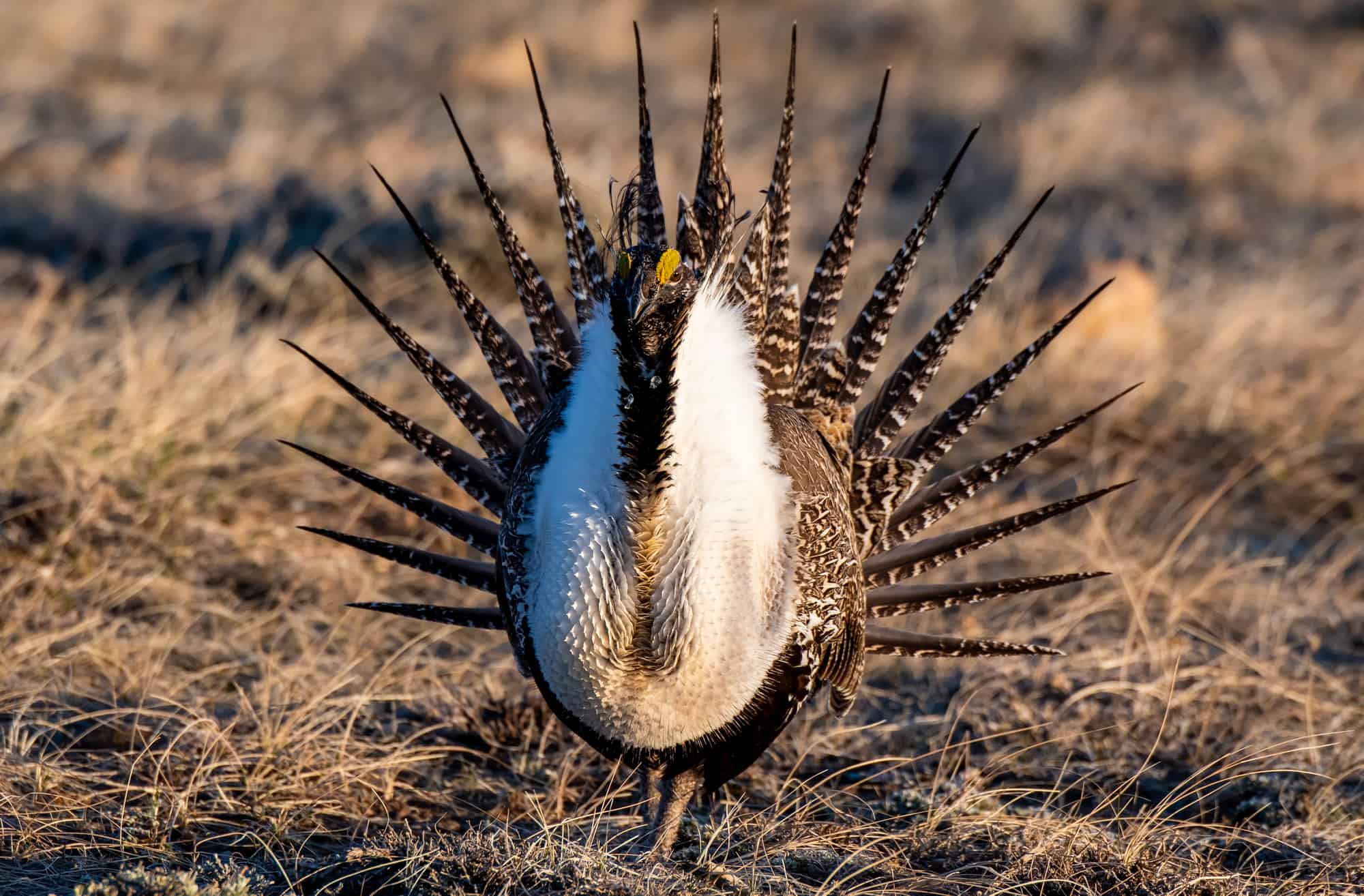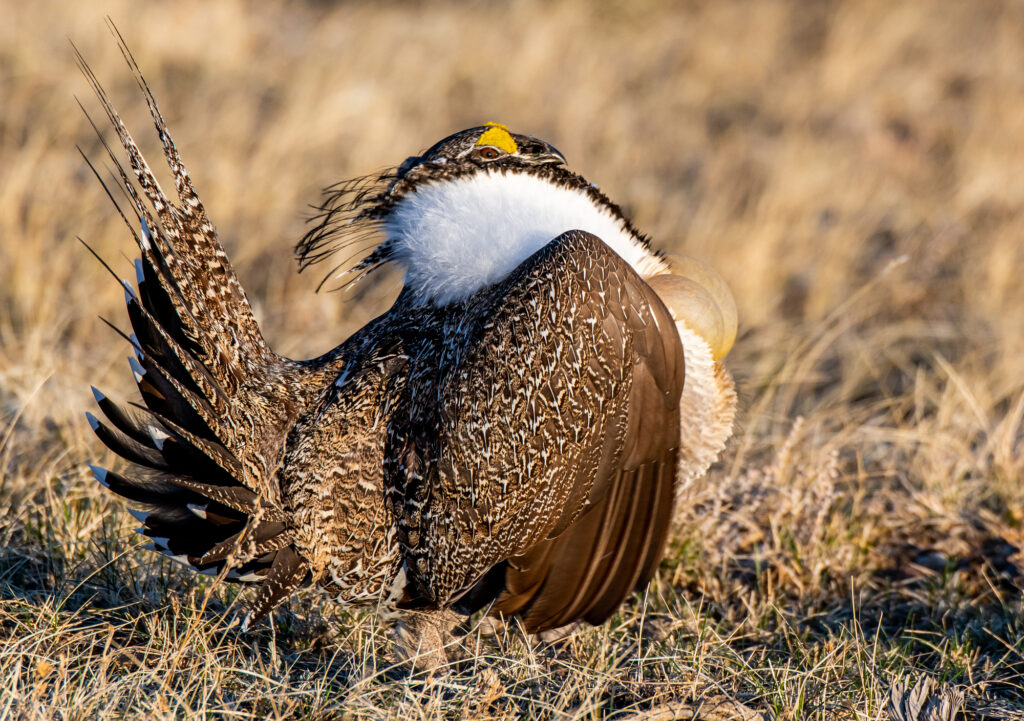The courtship rituals of birds offer some of the most breathtaking spectacles in the natural world. From the vocal gymnastics of the lyrebird to the dance of flamingos, birds have come up with some amazing ways to win each other’s hearts.
Few people, however, have had the privilege of witnessing the astonishing displays of a threatened bird from the Great Plains. When one lucky birder caught the greater sage grouse display on camera, the video went viral.
The only thing missing from the video is an urgent message that the species’ last remaining habitat is being penned for destruction. As the government makes some final amendments to its plans, we now have one last precious opportunity to secure the species’ future.
The Otherworldly Display of the Greater Sage Grouse
Each spring, male greater sage grouse congregate in groups known as ‘leks’ to perform an impressive courtship display before an audience of female onlookers.
@tednewy Male Greater Sage-Grouse displaying on a lek in Utah. One of the coolest breeding displays in nature. #greatersagegrouse #birddisplay ##birdlife #birdvideography #birdwatching #nature #birdwildlife #birdnature #wildlife #birdoftiktok #birdslove #birdlover #birdlovers #birds #bird #duniaburung #pencintaburung #burung ♬ suara asli – Tednew
By strutting, fanning their tail feathers, and popping the brightly colored air sacs from their chest, males attempt to convince females that they’re the most attractive specimen to mate with.
What you don’t see in this video is the scores of other males in the vicinity who are also competing for mating rights. Leks can sometimes reach up to 200 birds in size, meaning that competition to become the dominant male can be fierce indeed!
Scientific studies have deduced that males fight for the central position in the lek, and once established, the dominant male will mate with around 80% of the females. No wonder they work so hard to impress!
How Does the Male Make That Sound?!
These handsome-looking birds have become famous for the strange sounds they produce during their displays, but how exactly do they do it?
The first, high-pitched ‘swishing’ sound you hear is produced not in the bird’s throat, but by the wing feathers brushing firmly against the rough feathers of his throat as it inflates.
Next, you hear the booming of the two air sacs as they pop in such quick succession that it almost sounds like a single pop. The booming sound is so powerful that it can be heard nearly two miles away and is accompanied by a short whistle.
After the booming vocal pops, the bird lets out a final croak that is thought to be made as the last remnants of air are released from the beak.
Where and When You Can See the Greater Sage Grouse in Action

Greater Sage Grouses are sedentary sagebrush birds that can be found year-round in Western states from the Eastern fringes of California to Southern Saskatchewan in the North, and New Mexico in the South.
To see their famous mating ritual, you’ll need to visit open areas where they’re resident between late February through April. Favorite habitats for the rituals include meadows, ridges, roadsides, and other open areas that are typically surrounded by low-growing, sparse sagebrush.
Studies have shown that males are much more likely to congregate in large numbers when it’s not raining. These are fair-weather birds!
Greater Sage Grouse Conservation
Tragically, greater sage grouses have suffered some of the worst losses of any species over the last century. Today, only 3-7% of their former population remains.
One hundred years ago, there were an estimated 16 million individuals scattered across the Great Plains. They now only number between 200,000 to 500,000 birds and their range has been greatly reduced.
The species can no longer be found in British Columbia, Kansas, and Nebraska where they used to dwell, and further local populations, which include distinct subspecies, are at great risk of extinction.
The main cause of the decline is undoubtedly the loss of the sagebrush habitat that they rely on, especially during nesting time. It’s thought that overhunting and climate change may also play a part.
Saving the Greater Sage Grouse Makes Headlines in 2024!

For decades, efforts to win the greater sage grouse federal protection have been fraught with controversy. Although the severity of their decline is all too clear, the government has continually blocked official protection proposals because the remaining habitats need to be developed.
Because much of the sage grouse’s sagebrush habitat could be destroyed for oil extraction, solar farms, and ethanol production, big business, and many governors have fought ardently against protection measures.
In March 2024, after much pressure, The Bureau of Land Management (BLM) unveiled a draft for proposals to grant sage grouse habitat some degree of protection in the 67 million acres of public land that have been penned for energy production.
The issue is currently being fiercely debated before the final legislation is passed, and there’s an open invitation for the public to have their say!
What You Can Do To Help
If the thought of losing the remaining habitat of these magnificent birds moves you, the time to act is now!
The Bureau of Land Management is accepting public comments through June 13, 2024, via its website or physical letters. There are also several physical and virtual meetings being held across the United States during April.
At this pivotal point in the future of the sage grouse and other sagebrush birds, each of us has the precious opportunity to influence legislation that could determine the future of these precious remaining birds for future generations to come.
Use the ‘Participate Now’ function on the BLM website or send them an email to have your say now.

